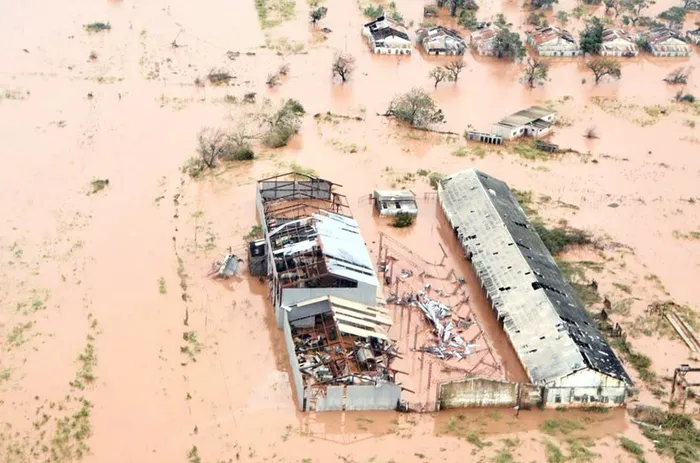SADC seeks to fast-track humanitarian centre operations

Picture: Emidio Jozine/EPA - African News Agency (ANA)/Taken March, 2019 – An aerial view of the damage from flood waters after tropical cyclone Idai made landfall in Mozambique’s Sofala province.
By Clarkson Mambo
SADC Member States have been urged to fast track the signing of the agreement that establishes the SADC Humanitarian and Emergency Operations Centre.
This was one of the decisions of the SADC Council of Ministers which met in Kinshasa, the Democratic Republic of Congo from 18-19 March 2023 to deliberate on regional integration.
The United Republic of Tanzania on 23 February 2023 became the first of the 16 Member States to sign the Memorandum of Agreement (MoA).
The signing ceremony took place in the backdrop of the record-breaking Cyclone Freddy, which brought heavy rains and flooding, leaving a trail of destruction in Malawi and Mozambique, with many lives lost.
The SADC Council of Ministers observed a Moment of Silence in solidarity with the Republics of Malawi and Mozambique, and approved emergency support for humanitarian assistance following an appeal from the President of Malawi who has declared a State of Disaster.
Southern Africa has in the last five years experienced an increase in weather-related phenomena like droughts and tropical cyclones such as Desmond, Enawo, Idai, Kenneth, Eloise and Cheneso.
The impact has been widespread in some countries in the eastern part of the region, resulting in loss of life, injury, disease and other negative effects on human, physical, mental and social wellbeing, as well as damage to property and infrastructure, loss of services, social and economic disruption, and environmental degradation.
This has hampered efforts to address poverty, food security and infrastructure development.
SADC leaders approved the establishment of the SADC Humanitarian and Emergency Operations Centre (SHOC) last year, as a dedicated institution in preparation for such eventualities.
The Republic of Mozambique is host of the SHOC which was launched by President Filipe Nyusi on 21 June 2021. The Centre is part of the region’s disaster risk management and resilience-building efforts and will be responsible for coordinating humanitarian and emergency response support to Member States when necessary.
Specific functions of the Centre include the provision of technical support to National Disaster Management Entities and other regional and international stakeholders towards improved co-ordination of disaster risk management and the establishment and maintenance of a regional Disaster Risk Loss and Damage Database.
Operations of the Centre will be guided by the SADC Disaster Preparedness and Response Strategy and Fund (2016-2030) whose aim is to enhance coordination for effective disaster preparedness, response and resilience.
To ensure that the SHOC is set up within the shortest possible period, it becomes imperative that SADC Member States follow in the footsteps of the United Republic of Tanzania and sign the Intergovernmental Memorandum of Agreement (MoA) that provides a legal basis for the operationalization of the Centre.
At the signing ceremony, George Simbachawene, the Minister of State in the Prime Minister’s Office responsible for parliamentary affairs, labour employment, youth and the disabled in Tanzania, said the Centre will deepen co-operation among Member States, improve security of people and properties in the region as well as establish closer relations among the people.
A representative of the SADC Secretariat, Dr Phineas Leonard Matto, expressed hope that the majority of the SADC Member States will follow suit and sign the MoA for it to enter into force and pave way for the full establishment of the Centre.
A minimum of 11 of the 16 SADC Member States are required to sign any protocol or agreement before it enters into force.
SADC Ministers of Justice as well as Attorney Generals had approved the draft MoA for the SHOC at their meeting held in July 2022.
In addition to the SHOC, the SADC region has put in place other complementary response mechanisms to assist in matters relating to disaster management.
One of the initiatives is the SADC Online Vulnerability Atlas developed by the SADC Regional Vulnerability Assessment and Analysis (RVAA) Programme, which is designed to store and share data on food, nutrition and livelihoods security from the 16 SADC Member States in the wake of disasters.
A Climate Data Processing Centre to provide timely early warning information such as prediction of flood and drought potential, and onset of the rainy season, as well as climate advisories and information has also been put in place.
SADC is also planning to develop and operationalize a regional database to record losses from disasters through a Regional Disaster Risk Information System while plans are afoot to establish a regional risk insurance scheme, which aims to improve rapid responses to natural disasters in the region.
Clarkson Mambo is a Zimbabwean writer and researcher
This article was first published in sardc.net.